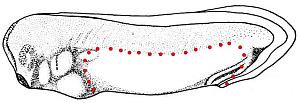结构基因组学
IntroductionProlonged treatment of proliferating mammalian cells with low doses of a histone deacetylase inhibitor trichostatin A specifically affects pericentric heterochromatin. Relocation of these ...
IntroductionProlonged treatment of proliferating mammalian cells with low doses of a histone deacetylase inhibitor trichostatin A specifically affects pericentric heterochromatin. Relocation of these ...
IntroductionIn cells and tissues the histone proteins that constitute the nucleosomes can present multiple post-translational modifications (Luger & Richmond 1998) such as lysine acetylation lysine an ...
IntroductionChromatin Immunoprecipitation (ChIP) experiments are routinely performed in many laboratories around the world to examine the occupancy of proteins or chromatin modifications over particul ...
IntroductionChIP (chromatin immunoprecipitation) is a powerful tool that allows one to determine whether and where a protein or protein modification is associated with chromatin in vivo. The technique ...
IntroductionThis is an alternative protocol for 3C that has been adopted by the author's lab. Much of it is identical to the previous version (PROT5). The major differences are in the amounts of DNA u ...
IntroductionEukaryotic chromatin is a complex of DNA and associated histone proteins which are involved in the higher order packaging of DNA into chromosomes. The chromatin state of a given DNA sequen ...
IntroductionAnalysis of protein-DNA interactions in the context of chromatin is pivotal for understanding the complex structure and functions of eukaryotic genomes. Packaging DNA with histones into nu ...
IntroductionWhilst great insights into the structure and properties of chromatin have been gained using chromatin samples extracted from native sources analyses of such material have limitations becau ...
IntroductionCross-linking Chromatin Immunoprecipitation (ChIP) has become a popular method to detect the in vivo binding of proteins to DNA. In general the protein/DNA complex is fixed with formaldehy ...
IntroductionThe organization of eukaryotic genomes into nucleosome arrays restricts DNA sequence accessibility to many nuclear factors. Thus most DNA-based processes require opening (or "re-closing") ...
IntroductionPost-translational modifications (PTMs) of histones specify regulatory functions on chromatin through the recruitment of downstream effectors or “readers” that can specifically recognize d ...
IntroductionThe polytene chromosomes found in the salivary glands of Drosophila larvae (and other diptera) provide a valuable model system in which microscopical techniques can be used to study the fu ...
IntroductionThe dynamics of chromatin structure is becoming an area of increasing interest. Both thermal energy and ATP-dependent chromatin remodelling enzymes can alter nucleosome structure and posit ...
IntroductionThe visualisation of specific DNA sequences in living cells achieved through the integration of lac operator arrays (lacop) and expression of a GFP-lac repressor fusion has provided new to ...
IntroductionThe visualisation of specific DNA sequences in living cells achieved through the integration of lac operator arrays (lacop) and expression of a GFP-lac repressor fusion has provided new to ...
This protocol was provided to us from the Grainger lab and modified by M. Khokha to include the lead brick for better squashing.1. Place 10 Nieuwkoop & Faber Stage 26-34 tadpoles into a dish of deioni ...
This protocol was provided to us from the Grainger lab and modified by M. Khokha to include the lead brick for better squashing.1. Place 10 Nieuwkoop & Faber Stage 26-34 tadpoles into a dish of deioni ...
We have been karyotyping animals in the Grainger lab to confirm that the stocks maintained in the lab are indeed X. tropicalis and to establish that wild-caught animals being used for gynogenesis are ...
Materials Fresh venous blood 8Heparinized syringesEagle's spinner modified media with PHACulture flasksTissue culture grade incubator at 37° C10 µ g/ml ColcemidClinical centrifuge and tubes0.075 M KCl ...






